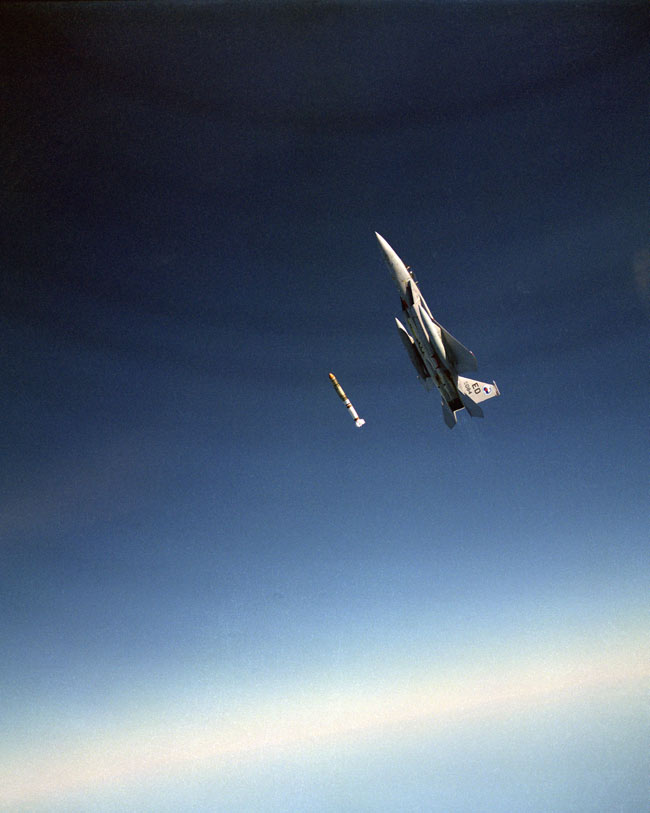How to Down a Satellite: Go Back 22 Years

The U.S. Navy's planned attempt to destroy a de-orbiting spy satellite using a ship-launched missile this month is making headlines -- but if the attempt is successful it won't be the first time the United States government has used a missile to shoot a satellite down.
More than 22 years ago, on Sept. 13, 1985, U.S. Air Force Maj. (now retired Maj. Gen.) Wilbert "Doug" Pearson became the first pilot ever to shoot down a satellite, when an ASM-135 ASAT anti-satellite missile launched from his F-15A Eagle at an altitude of 38,100 feet in the Pacific Missile Test Range some 200 miles west of Vandenburg Air Force Base, Calif.
Writing in 2001 for the Air Force Flight Test Center's (AFFTC's) Web article series Moments in Flight Test History, Dr. Raymond Puffer, the AFFTC's historian, noted that Maj. Gen Pearson's successful ASAT mission -- dubbed the "Celestial Eagle Flight" -- made him "the first and only space ace." [Satellites Gallery: Science from Above]
(However, the United States' then-Strategic Defense Initiative Organization successfully collided two Delta upper stages in low earth orbit in 1986, in its Delta 180 experiment. Then, early in 2007, China shot down an old weather satellite using a ground-launched ballistic missile.)
Maj. Pearson's mission Sept. 1985 mission represented the culmination of a six-year development and test program for the ASAT missile. The mission called for Maj. Pearson, the director of the U.S. Air Force's ASAT Combined Test Force, to fly a highly accurate flight profile so his aircraft would arrive at a precise firing point over the Pacific Ocean at a precise time.
Flying at just above Mach 1.2, Maj. Pearson pulled up into a 3.8g, 65-degree climb that reduced the speed of his aircraft to Mach 0.934, just below the speed of sound. At 38,100 feet, the ASAT missile launched automatically, accelerating up to escape velocity as it streaked towards its target. [Satellite Shoot Down: How it Will Work]
The infra-red sensor of the ASAT's miniature homing vehicle (MHV) -- the 30-pound third stage of the 2,700-pound, three-stage missile -- detected and tracked the intended target, the obsolete, 2,000-pound Solwind P78-1 solar laboratory launched in 1979 and orbiting at an altitude of 345 miles.
Get the world’s most fascinating discoveries delivered straight to your inbox.
Eight solid-rocket motors ringing the circumference of the MHV were used to perform final trajectory adjustment maneuvers, with four more small rocket motors in pods at the rear of the MHV controlling its attitude as the MHV revolved around its long axis some 30 times a second to provide directional stability.
At a closing velocity of about 15,000 mph, the MHV collided with Solwind P78-1, the huge transfer of kinetic energy shattering the satellite instantly into pieces of debris and -- NASA scientists theorized later -- converting enough of the two bodies' kinetic energy to heat to vaporize the plastic materials inside Solwind and coat its brightly reflective metal surfaces with soot.
Last year, diligent research by Staff Sgt. Aaron Hartley of the Florida Air National Guard revealed that one of the aircraft the Florida ANG was operating was the same F-15A -- Air Force serial number 76-0084 -- that Maj. Gen Pearson had flown on his historic Celestial Eagle mission.
By 2007 Maj. Gen. Pearson's son, Capt. Todd Pearson, was an active-duty F-15 pilot (and General Pearson himself was by then the vice president of the Lockheed Martin F-35 integrated test force). The stage was set for Capt. Pearson to fly his father's history-making aircraft to commemorate the 22nd anniversary of the Celestial Eagle flight.
Follow Live Science @livescience, Facebook & Google+.
